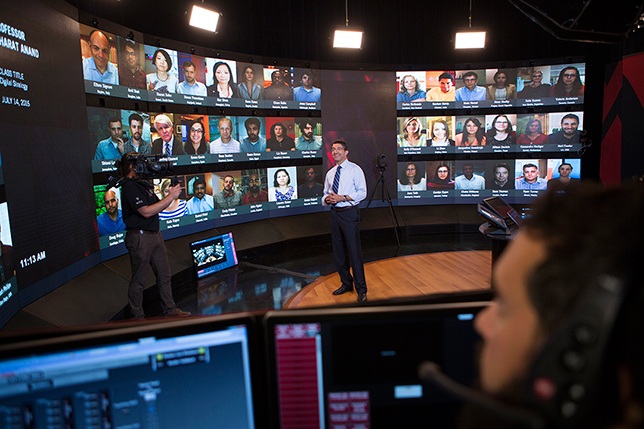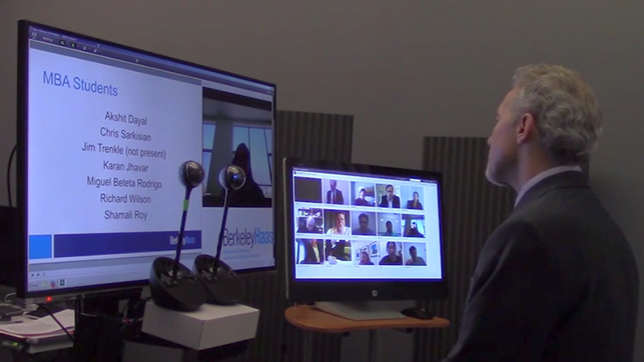Making Virtual Classrooms More Interactive
Harvard and UC Berkeley share two different approaches to helping online business school students feel like they're attending class in person.
- By Dian Schaffhauser
- 08/10/16

Harvard Business School's HBX Live studio
You know you have a truly collaborative online instructional platform when students take selfies of themselves posing on a display with their remote instructors. That has actually transpired with people who experience Harvard Business School's HBX Live virtual classroom. The environment — really a high-end production studio with some major technical twists — was introduced a year ago to reproduce in an online format the rich give-and-take that's essential to the school's case method style of teaching.
Located in Boston's WGBH public television station, the studio allows students from anywhere with an internet connection to interact in real time with each other and faculty members. The space is dominated by a semi-circular video wall that's 30 feet wide and 15 feet high, displaying up to 60 students simultaneously — each appearing bigger than life on an LED screen 2.5 feet wide and 2 feet high. Across from that wall hang two 90-inch touch monitors that act as digital blackboards on which the instructor can write or diagram. According to Elizabeth Hess, the senior managing director over HBX Live as well as Harvard Business School's HBX digital learning initiative, instructors work in the studio space with the help of a production crew that manages all of the technical aspects of the setup.
It's hard not to contrast all of that with a much smaller-scale system built for use by the University of California Berkeley Haas School of Business, in which an instructor can sit in front of one or two large touch displays showing all class participants, and call on individual students by tapping on their moving faces. The teacher may or may not have somebody else in the room helping with production aspects.

The virtual classroom system at UC Berkeley's Haas School of Business
Both setups were designed with a fundamental purpose: to engage online students and make them feel as if they're physically sitting in the classroom, even to the extent of being hyper-aware that they could be called on at any moment to contribute something to the discussion. In spite of obvious differences, both programs contribute ideas that could help more traditional online initiatives perk up their own efforts.
Capturing Interactivity
Interactivity is an essential aspect for business schools — and other professional schools for that matter. "Learners tend to cite convenience as a driving factor for considering an online or hybrid alternative to a traditional classroom program experience," pointed out Zach McHenry, the manager of course delivery and support for the Berkeley Resource Center for Online Education (BRCOE). But for professional degree seekers, he said, "the networking and peer connection is almost more important than class work."
A new department spun off from the University Extension program, BRCOE helps campus clients with online program development, marketing and recruitment, pedagogical design, media production, and course support and delivery services. In the spring of 2013, Berkeley's business school approached BRCOE about providing a rich "live session" experience in fully online and hybrid MBA classes. The goal: to get beyond the standard online offerings and create a more interactive platform. So often, McHenry noted, "teaching virtually robs instructors of the ability to 'read' their students' facial and body cues; to see who is engaged, confused, distracted or even absent. This makes online instruction feel lonely, disempowering and, too often, more like a lecture than a discussion."
For the new platform's core infrastructure, BRCOE selected Adobe Connect as best-of-breed for videoconferencing. But even best-of-breed couldn't come close to accommodating the scale the university needed — with 50 or more people in a class. While Connect "claims" unlimited camera feeds, "there is still a practical limit," McHenry said, whether bandwidth, display real estate or "just noise," which caps the maximum practical class size.
It was the addition of Vantage Point from Refined Data, an Adobe partner, that made the difference. "If Connect is the engine in this project, then Vantage Point is the rocket fuel," McHenry emphasized.
The Refined Data software allowed BRCOE to incorporate two standout features in the online course platform: the ability for an instructor to "activate" any remote student to take the lead by tapping on the display, and the option to form breakout groups for student team interaction. Both features have been key to making online students feel fully involved in the classroom experience.
What's more, the equipment is no barrier to entry. All it takes, said McHenry, is a laptop, a webcam and, ideally, a secondary monitor for viewing students while using the primary display for presentations and screensharing. He estimated that for about a thousand dollars, not counting the software, faculty can deliver a "deeply engaging classroom experience." (The higher the budget, the bigger the displays.)
Students tend to agree. "I really like the live session format," said one participant in a course evaluation. "It does feel like a class." Added another, "The live lecture sessions made it feel more interactive, which was more engaging than just watching content on our own time."
High Production Values Pay Off
HBX Live is an offshoot of HBX, a course platform developed at Harvard for primarily asynchronous learning experiences. Among the initial users of HBX Live have been people attending Harvard Business School's executive education and corporate training programs as well as those pursuing its Credential of Readiness (CORe), a small bundle of intense courses designed for students from any discipline who want to acquire a business sensibility.
Because there's a logistical limit to the number of people who can be part of the main event, HBX Live uses a lottery system to choose those who will appear on the big screen. Additional students can tune in as "observers" to view the stream and participate in polls and online chats.
The studio experience provides online students with a rare chance to talk with their instructors, many of whom are celebrity experts in the world of business. CORe students, for example, don't normally get real-time faculty interaction — the lectures are delivered by video, Hess explained. So their initial response when they participate in HBX Live is to say, "You're real!" "They enjoy the opportunity to ask faculty questions and to hear from them directly," she said.
HBX Live relies on high production standards to deliver that "insider" sensation. "We're actually producing the session like you would a television broadcast," Hess noted. The studio uses still and roaming cameras as well as live audio and video feeds to capture the interactive discussion. At any given moment, she said, the view might focus on the instructor talking or working on the digital blackboard; it might show the video wall with the entire class watching the action; or it could show two students having a discussion. When a faculty member puts out a question, people can literally or digitally raise their hands, and the instructor can call on them. "It's really trying to replicate the [classroom] experience as much as possible visually to get them engaged and participating."
To ensure professor comfort, the environment is designed to feel "very much like an existing class, so [faculty can] step in and not have to manage any technology — and really be all about focusing on facilitating the discussion," Hess said. "Faculty members who are used to doing case-based teaching can really walk in and start teaching in the studio after a 15-minute orientation."
Behind the scenes, four people are on hand to make the operation run smoothly:
- A handheld camera operator films the movement on the stage;
- One person does end user support;
- A technical director manages the video feeds and lining up the next view; and
- A sound engineer handles the audio.
That sound engineer isn't simply confirming that the speaker can be heard. He or she is also managing the individual audio feeds coming in from the 60 participants. "We ask that all of the students keep their mics live," said Hess. "We want to hear the reaction — the 'ooohs' and 'aahs' and laughing — very much like a regular classroom. It's quite effective. It helps in making the experience real." But when a dog barks or a baby cries, she added, the audio engineer can bring down the level of that individual's audio feed to eliminate ambient noise that could be distracting.
Besides the handheld camera, six fixed cameras on the floor provide additional views of the room while also giving students on the video wall a sense of where they're sitting in the classroom. That's important, Hess pointed out, so that they know when a faculty member starts to turn toward their section; after all, they might be called on to speak.
As for the faculty, because they can see who's raising their hands and they can watch student reactions to commentary, "they can really respond," said Hess. "They can take all those visual cues to engage the people most intent on speaking or [those who] are going to drive a really interesting discussion."
Of course, said Hess, there is one challenge faculty have to deal with in this setup that they don't struggle with in their face-to-face courses: "It's more intense than the classroom because everyone is sitting in the front row."
About the Author
Dian Schaffhauser is a former senior contributing editor for 1105 Media's education publications THE Journal, Campus Technology and Spaces4Learning.